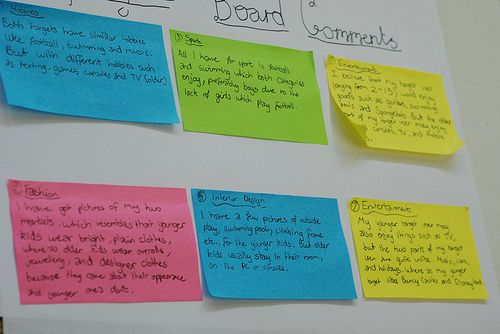How to process marketing research data for insights
The method below outlines a process:
- Pick a color for quantitative data (the numbers). This should be the database research numbers on growth, sales figures, potential market segment they own, rate of defects, price points, satisfaction scores like star reviews, number of pages on the first page of Google, Twitter/Facebook/Tumblr/Flickr/YouTube followers – basically any hard numbers that can be validated by 3rd party sources and can’t be spun by a PR firm.
- Pick a different color for qualitative data (the emotional responses). Here is where you write down all the interesting tidbits – customer comments, social media mentions, press hits, blog comments. Just pick the best pieces for each competitor for now. You can easily be very overwhelmed here. Remember, you are looking for big gaps in the emotional experience of that brand as evidenced by customers feedback on these channels.
- Head to the whiteboard and list all your competitors in order of market leaders (consider ranking by sales revenue or market share – real or perceived) on the left hand side of the board and make rows, much like a spreadsheet. Drop in the post-it notes from your research next to each competitor under the column headings “Data” and “Feedback”. Finally, leave a space on the far right for additional questions that can be written in a separate color with a giant question mark at the top of that column. These are things that you would like to know more about or feel unsure about. It feels good to write it down and file it away for now, which we need to do to get our creative juices flowing.
- Take at least a 30 minute break. Next, step back from the board at least ten feet and pull up a chair with a stack of post-it notes in hand. Where are the holes? The colors will show you immediately if you are weak on quantitative or qualitative data for a particular company.
- The questions in the far column tells you where you need to go next. Fill in the holes and go through steps 1 – 4, until you feel you are confident in answering the nagging questions in your head.
Tip: Keep a stack of hot-pink post-it notes for the “ah-ha” ideas as you work through the exercise. Looking at the matrix of competitors the ideas should start to leap out at you. Jot these down some place where you can return to them later. Don’t worry about if you can technically implement these ideas or if they feel silly. Just capture them. Your mind will start to make connections in ways you will be surprised.
Following this research exercise, we have a fairly solid understanding of the big picture from not only a brand but also from a business performance perspective.
Key takeaway: This quick research shows us what success brands in our space are having in their customer experience online and also where they might be stumbling. We can then make sure we don’t make the same mistakes in our efforts. Inevitably this exercise leads to some big “ah-ha” moments on ways to add value to the digital experience – and we can back it up with real data (qualitative and quantitative) for getting internal buy-in.
